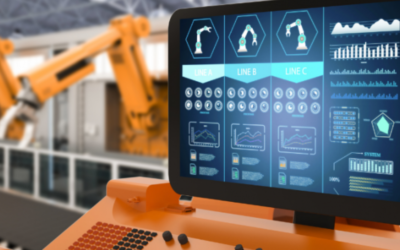IoT has been growing year over year, with the market size reaching USD 4.8 billion in 2021. The technology is only expected to become more prominent, as experts predict market growth at a CAGR of 25.4 percent from now to 2028, with estimations putting the market size at USD 1,854.76 billion by 2028.
This rapid growth is not surprising, as IoT is extremely beneficial to companies of all industries, with the devices using AI and machine learning to bring intelligence and autonomy to systems and processes, such as autonomous driving, industrial smart manufacturing, medical equipment, and home automation.
However, to truly reap the advantages of IoT, companies have realized they need to pair the technology with 5G. While these devices and applications are driving a new wave of transformation for industries, they require exceptional capabilities, such as firm control over where data is stored and executed, high-performance and secure wireless connectivity, and millisecond-grade latency.
5G technology offers greater speed in the transmissions, and lower latency, therefore allowing a greater capacity of remote execution and a greater number of connected devices, with the possibility of implementing virtual networks. Because of these benefits, 5G networks will go a long way towards improving the performance and reliability of IoT-connected devices.
For this reason, organizations are increasingly looking for adequate 5G services and platforms to meet their digital transformation needs for both the benefit of their own company, as well as their employees and customers.
This week, Telefónica and Pente Networks, a developer of a revolutionary enterprise cellular 4G/5G platform, announced they are working on a managed 5G Cloud service to enable advanced transformation use cases for enterprises. Telefónica and Pente are looking to democratize the delivery of advanced industry transformation through a managed 5G Cloud service using Pente’s packet core solution.
The service follows a cloud-first approach to create a 5G Cloud service that leverages the full potential of the cloud to automate integration delivery, operations, and integration with services on top – all wrapped with a simple digital view of the service for customers. The result is a more replicable end-to-end product that shortens the delivery time from weeks to just a few hours. At the same time, this massive automation coupled with a simple user interface designed by Telefónica reduces the cost and complexity barriers for enterprises willing to embrace 5G and Edge computing services.
“The same fully secure and private 4G/5G network supports highly available, high-quality real-time communications, including voice, messaging, and video, to data networking at the edge, important to edge computing and Industry 4.0 solutions,” said David del Val, CEO of Telefónica I+D. “Telefónica can now spin up private networks in hours or days, not weeks or years, and can manage them through a single pane of glass using Pente’s advanced administrative console with its intuitive, IT-friendly experience. An internal team effort that is being developed jointly by Telefónica’s Innovation team and the IoT and Big Data division of Telefónica Tech”.
The two companies have already been developing products together in the past, initially focusing on the industrial Telefónica can combine 5G connectivity with a new generation of hyperscaler OnPremise and Edge platforms as a turnkey solution. With their newest collaboration, enterprise customers can access the full range of hyperscaler services and reap the benefits of the cloud to build, manage, and scale local applications using familiar hyperscaler services and tools, which work in perfect harmony with the Pente connectivity platform.
Current Private 5G Edge implementations are mostly based on a special project approach, requiring much engineering effort to integrate devices, connectivity, cloud, and applications. Telefónica has developed a platform that uses CI/CD tools to automate the integration of the different service components, including the core Pente network. This platform enables the generation of an operational model that maximizes automation in the testing, deployment, and operation of applications on top of the platform.
Pente offers a perfect complement to the company’s “API First ” approach, which provides a programmatic integration between the Pente Core and Telefónica’s platform for lifecycle control and to integrate with services on top. Activities cover the deployment of Pente Core on a hyperscaler infrastructure, integration with Telefónica’s platform, and end-to-end service automation.
On the other side of the collaboration, Telefónica ranked among the three global leading providers in both “Hyperscale IoT Connectivity” and “Vertical” capabilities, according to the Communications Service Provider IoT Peer Benchmarking Report 2021, making them already experienced in the IoT world, which 5G is quickly becoming a part of.
Working in perfect harmony with the Pente connectivity platform, Telefónica can combine 5G connectivity with a new generation of hyperscaler OnPremise and Edge platforms as a turnkey solution. This means enterprise customers can access the full range of hyperscaler services and benefit from the advantages of the cloud to build, manage and scale real-time applications using familiar hyperscaler services and tools.
“5G and Edge are bringing a new wave of transformation, in the same way as mobile broadband and the cloud did some years ago. Telefonica is in the perfect position to create services combining 5G Connectivity, cloud edge, business applications, and devices. By using cloud-native principles, we have transformed how the services are delivered to generate turnkey services,” added del Val. “Now we can spin up private networks connected to apps on the cloud edge in hours or days, not weeks or months, and abstract most of the underlying operational complexity of current 5G networks. This will enable us to reach more client segments and industries in the coming years.”
Originally published on IoT Evolution World
The Inevitable Explosion of Enterprise 5G Networks
Today, technological innovations are rapidly reshaping the landscape of a variety of industries, and none more so than the introduction of 5G. While 5G networks began rolling out in the United States and around the world in 2018, the technology is now expected to fuel transformative new technologies, not just for consumers but also for businesses, infrastructure, and defense applications. The rapid spread and adoption throughout the country has already led to the advent of private 5G networks.
For Industrial IoT, Will the Future of Enterprise 5G Networks be Federated?
As more industrial companies implement more connected solutions, the concept of federated networks is taking off as an opportunity for entrepreneurial exploration and a strong alternative to legacy “telecom” providers who are fighting to maintain their “walled gardens.”
With The Historic Infrastructure Bill Signed Into Law in the United States, Educators Have More Resources Than Ever To Move Forward
Yesterday, the long-promised Infrastructure Bill was finally signed into law by President Biden, following a successful negotiation across the aisle in Washington, DC.
One of the most exciting aspects of the bill is access to high-speed broadband, critical for the new world of digital learning and working.


